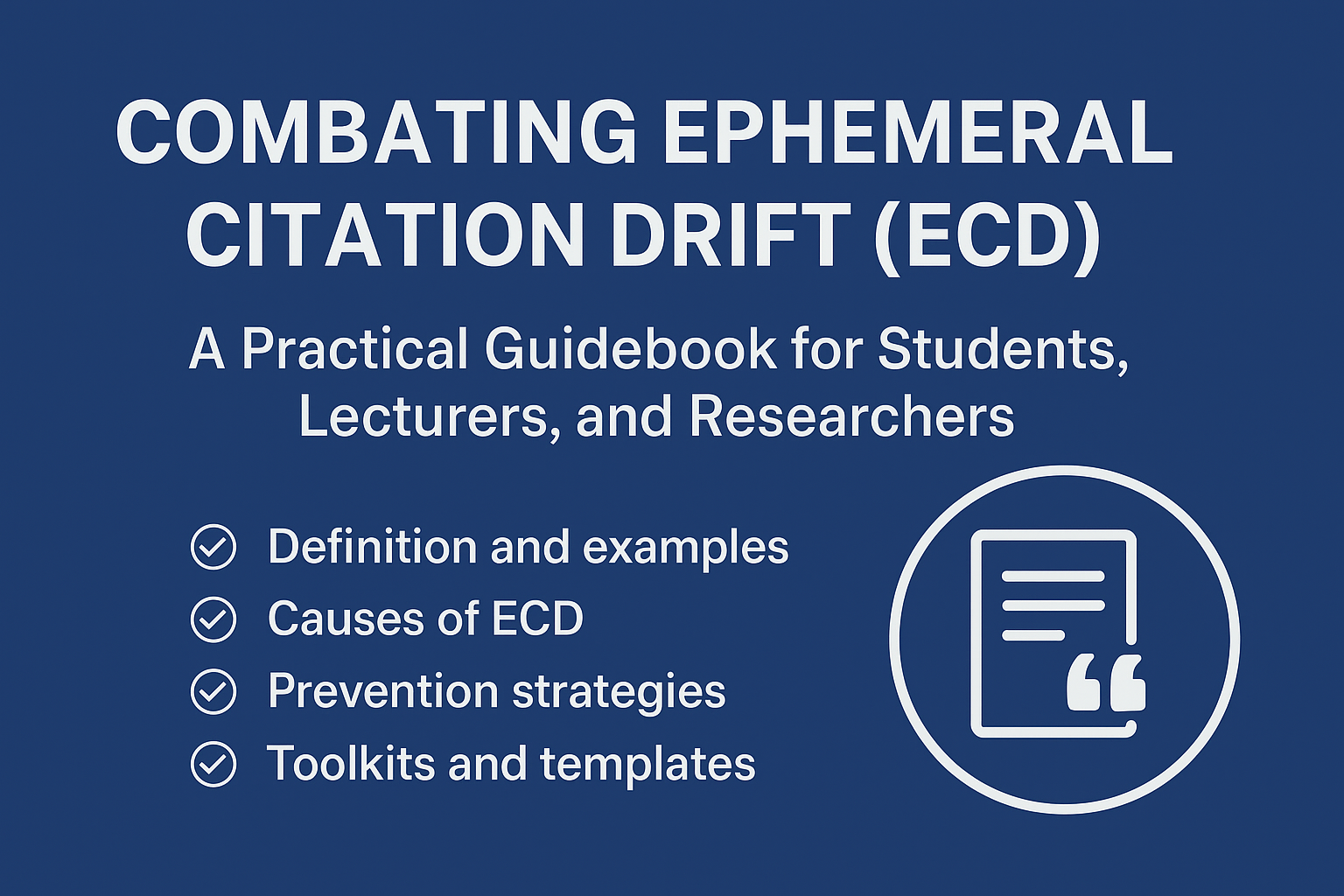
Introduction
Academic writing in the UK is globally respected for its standards of rigour, originality, and critical thinking. However, beneath the surface lies a subtle but growing issue: Ephemeral Citation Drift (ECD). This phenomenon occurs when secondary or tertiary citations gradually distort the meaning of original sources, eroding the accuracy of academic work over time.
ECD differs from plagiarism. It is not about theft, but about distortion through reliance on indirect sources. In the UK, where students face pressures from assignment deadlines, paywalled journals, and varying access across institutions, ECD quietly undermines both essays and published research.
This manual provides a step-by-step toolkit for recognising, preventing, and correcting ECD. It offers downloadable templates, checklists, and guides designed to protect academic integrity while supporting student success in the UK higher education context.
Chapter 1: Understanding Ephemeral Citation Drift (ECD)
Definition
Ephemeral Citation Drift (ECD) is the process through which academic meaning “drifts” away from its original intent as citations move further from the source.
Example of Drift in UK Student Writing
- Original Source (Pedagogy Journal): “Digital technology can support student collaboration when integrated with effective teaching practices.”
- Secondary Source (Blog summary): “Digital technology supports student collaboration.”
- Tertiary Use (Undergraduate essay): “Digital technology always guarantees student collaboration.”
By the time the idea enters a student’s essay, the nuance of “conditional effectiveness” has drifted into an absolute claim—potentially misleading the argument.
Chapter 2: Causes of ECD in the UK Context
- Paywalled Journals and Database Access
- Students at Russell Group universities may have wider access than those at smaller institutions, leading some to rely on summaries and abstracts instead of full texts.
- Time Pressures and Deadlines
- UK assessment structures often demand multiple essays within weeks, encouraging shortcuts.
- Dependence on Lecture Slides & Summaries
- Students sometimes cite what lecturers present rather than the actual academic text.
- Over-Reliance on Online Summaries
- Blogs, forums, and open notes (often inaccurate) circulate among UK students as “quick sources.”
- The REF (Research Excellence Framework) Pressure
- UK academics may focus on output quantity, indirectly encouraging students to cite “safe” secondary summaries rather than exploring original materials.
Chapter 3: Consequences of ECD in UK Academia
- Weakened Student Essays: Essays may lose nuance, leading to lower marks.
- Credibility Risks: Misrepresenting sources may trigger academic integrity concerns.
- Distorted Knowledge: Future researchers unknowingly build on inaccurate claims.
- Loss of Academic Rigor: The UK’s international reputation for scholarly excellence depends on accurate knowledge transmission.
Chapter 4: Strategies to Prevent ECD
For Students
- Always attempt to access the original source. Many UK libraries provide inter-library loans or open-access alternatives.
- Use annotated bibliographies to ensure you only write about what you have read.
- Cross-check claims by comparing at least two independent accounts.
For Lecturers
- Design assessments requiring students to quote and reference primary texts.
- Run workshops where students trace drifted citations back to their origins.
- Include citation accuracy in marking rubrics.
For Researchers
- Model best practice by citing responsibly and avoiding blind reliance on others’ references.
- Encourage use of open-access repositories such as CORE (UK Open Access Research).
Chapter 5: Role of Technology in UK Universities
- Zotero/Mendeley/EndNote: Free or institutionally licensed reference managers.
- CORE (https://core.ac.uk/): Provides access to millions of open-access UK research papers.
- British Library EThOS (https://ethos.bl.uk/): Free access to UK doctoral theses, often bypassing journal paywalls.
- AI Tools: Citation checkers that compare summaries with original sources can detect drift early.
Chapter 6: Templates & Downloadable Tools
These templates can be provided as downloadable PDF files here: Combating Ephemeral Citation Drift (ECD): A Practical Guidebook for Students, Lecturers, and Researchers and ECD Checker Toolkit
Template 1: Primary Source Verification Checklist (Downloadable)
- Have I accessed the original source?
- Have I paraphrased the argument in my own words?
- Have I included the correct page number(s)?
- Have I cross-checked accuracy with at least one other reliable source?
- Am I avoiding reliance on summaries, lecture slides, or blogs?
Template 2: Citation Chain Tracker (Excel Format)
| My Claim | Source Cited | Original Source | Drift Detected? | Action Taken |
|---|---|---|---|---|
| “Technology guarantees learning” | Blog summary | Journal article | Yes | Re-read journal, corrected wording |
Template 3: Annotated Bibliography Framework (Word Format)
- Full Reference: APA/Harvard
- Summary of Original Text (2–3 sentences)
- My Interpretation (2–3 sentences)
- Verification Status: Primary [ ] Secondary [ ]
Template 4: Source Reliability Checklist (Downloadable PDF)
Criteria:
- Peer-reviewed (Yes/No)
- Accessible in full text (Yes/No)
- Directly supports claim (Yes/No)
- Cited with page numbers (Yes/No)
💡 Students can access free support discussions and peer Q&A for citation challenges via platforms like Meet2Share Academic Questions.
Chapter 7: Case Study – UK Higher Education
UK universities face unique challenges:
- Russell Group universities enjoy extensive subscriptions; others face patchy access, leading to reliance on “Google Scholar snippets.”
- Postgraduate dissertations often rely on “safe-cited” sources (heavily cited works) without confirming the original.
- International students in the UK may be especially prone to drift when English is not their first language, leading to unintentional misrepresentation.
Chapter 8: The ECD Integrity Model (Step-by-Step Guide)
- Identify the claim you want to cite.
- Locate the earliest version of that claim.
- Read and paraphrase carefully.
- Record exact wording + page numbers.
- Cross-verify against secondary summaries.
- Log entry in the Citation Chain Tracker.
- Place in annotated bibliography.
- Re-check before submission.
Conclusion
Ephemeral Citation Drift (ECD) is a subtle but damaging issue in UK academia. By embedding verification checklists, citation trackers, annotated bibliographies, and institutional workshops, students and lecturers can preserve scholarly rigour. Digital tools like CORE and EThOS help democratise access, while platforms such as Meet2Share Questions support students in real-time.
With commitment from both learners and institutions, the UK can continue its reputation for excellence in academic writing by ensuring that knowledge is transmitted accurately, not drifted.